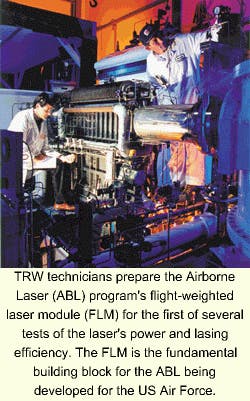Congress has overruled plans by the US Air Force to slow down the pace of the Airborne Laser (ABL) project to make funds available for other Air Force programs. In the Defense Appropriations Bill for the fiscal year that starts in October, lawmakers reversed a proposal to cut the ABL program budget; instead they gave the Air Force more money than it requested for ABL while barring the Air Force from spending those funds on any other project.
The ABL is an Air Force project to develop a Boeing 747 equipped with a chemical laser that could shoot down enemy ballistic missiles soon after they were launched. TRW (Redondo Beach, CA) and Lockheed Martin (Bethesda, MD) are working with Boeing (Kent, WA) on the project (see photo).
The program has enjoyed wide support on Capitol Hill, particularly as lawmakers have become increasingly worried about the prospect of rogue nations developing long-range missiles tipped with crude nuclear or biological warheads. But, in January, the Clinton administration requested $149 million for the ABL program in 2001, roughly half this year's funding of $304 million—a reflection of Air Force officials' desire to see money go to other projects.
The lawmakers' response? In the appropriations bill, they allocated $234 million for the ABL program, or $85 million more than the Clinton administration had requested. Moreover, to keep the Air Force from trying to move some of that money to other projects, the final defense bill included an explicit provision, known as an "earmark," that forbids any other use of the $234 million.
Other laser projects
That was far from the only laser-related project on which the Republican-controlled Congress decided to spend more money than President Clinton had requested. For example, the defense bill also included $15 million for the Tactical High Energy Laser project, a joint US-Israeli effort, run by TRW, to develop a portable deuterium fluoride laser that could be used against enemy missiles. Clinton had requested no funds at all for this project.
Sen. Pete V. Domenici, a Republican from New Mexico, where the Tactical High Energy Laser project is conducted, said he was pleased by Congress' decision to provide additional funds for it and the ABL project. "I strongly believe that lasers will transform both our offensive and defensive military means in the years to come," he said. "We should fully support these programs and address shortfalls in the science and technology funding in these technologies to ensure more rapid development and fielding of high-energy laser weapons."
The final version of the defense bill, written by a conference committee of members of the Senate and House appropriations committees, resolved discrepancies in funding levels in the individual defense bills approved by each chamber. The conference bill also provided $38 million for the Pentagon's research into high-energy lasers, including the Pentagon's High Energy Laser Systems Test Facility, operated by the US Army in New Mexico. That was almost twice the $15 million that the Clinton administration requested for the facility and repeats the recent history of Congress adding extra money to the facility's budget. The additional money includes $20 million for a heat-capacity solid-state laser program, of which $5 million is for industrially developed solid state laser-diode arrays, and $3 million is for optoelectronics.
In the Army's budget, the conferees also added $3.5 million for an aero-optics evaluation center, and $2 million for a project in optics manufacturing. The Navy received $5 million for free-electron-laser (FEL) research, $2 million for research into fiberoptic wireless communications, $10 million for mine countermeasures using optical and other technologies, and $1 million for a project to develop prosthetic eyes that would help disabled or handicapped service members remain on duty.
The Air Force received the full
$32 million that it had requested for directed-energy-technology research, as well as $73 million for its work on the Space-Based Laser program, $10 million more than the Clinton administration had requested. The Ballistic Missile Defense Organization (BMDO) received $75 million—the amount the administration had requested—for its portion of the project. A program to develop medical applications of the FEL received $20 million, or $5 million more than the Clinton administration had requested.
In smaller projects, the Air Force received $3.5 million for research on active optics for astronomical use, $3.2 million for development of laser tools for materials processing, and $1.4 million for research into fiberoptic control technologies. The administration had not requested funds for any of these programs.
Other small projects that received federal money even though the administration hadn't requested it were a laser communications demonstration at the BMDO, which received $5 million; a project in laser-plasma point-source x-ray lithography, which received $5 million; a solid-state dye-laser project, which received $3 million; and a project to develop electro-optical sensors, which received $5 million.
